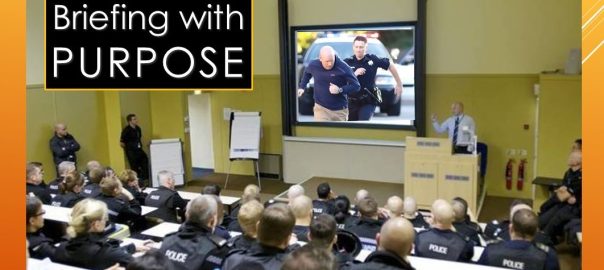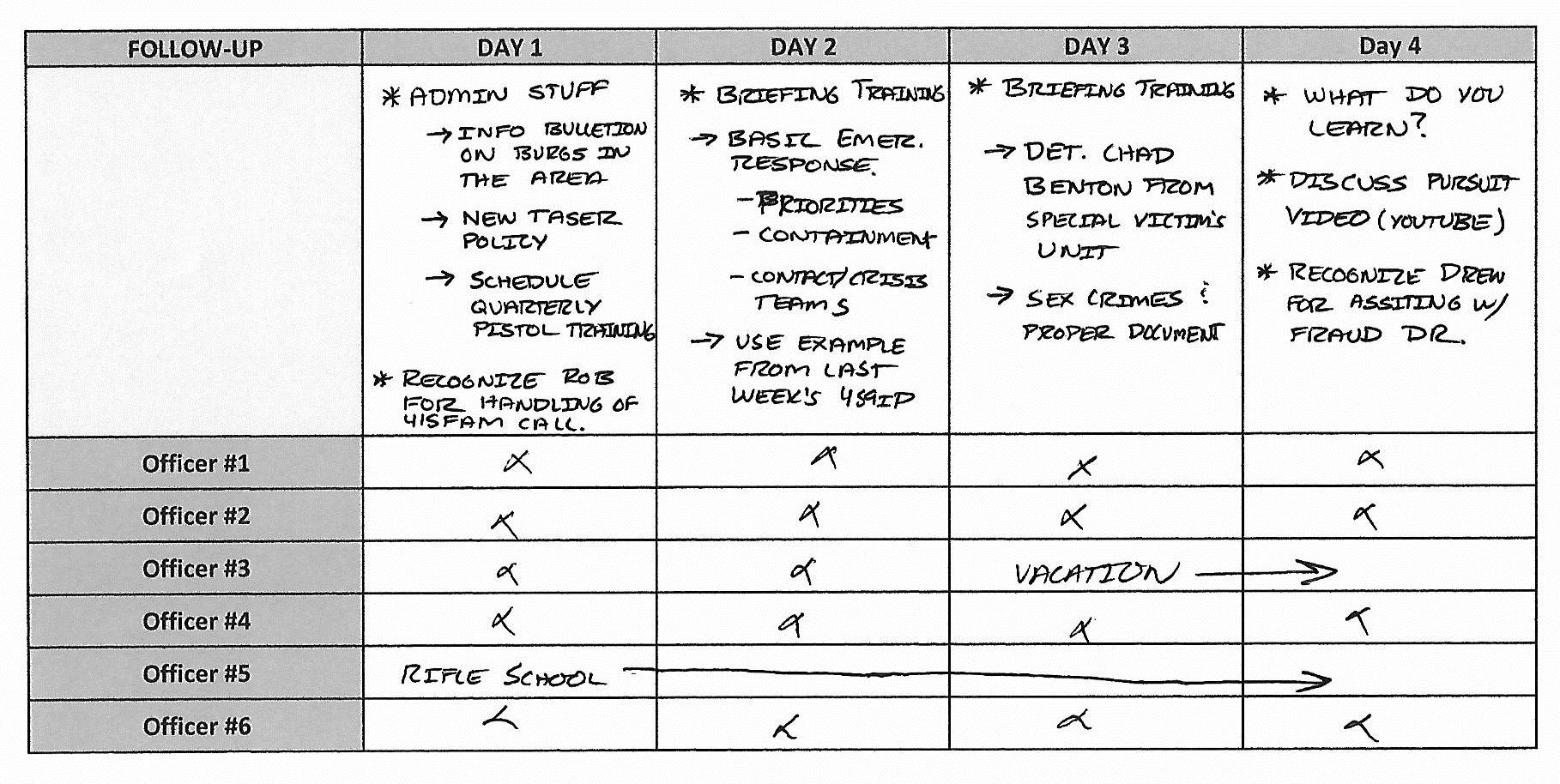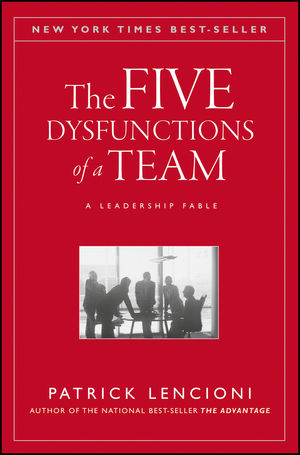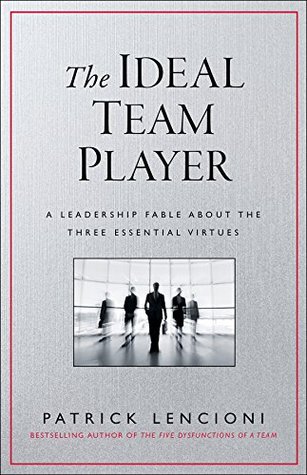One of the responsibilities of my current position is to coordinate, organize, and instruct portions of our department’s Sergeant-In-Training (SIT) School. This school is designed to introduce prospective sergeants to the basic expectations, tasks, and responsibilities of the sergeant position before they head out for a five-week sergeant field training experience.
One of the most highly regarded portions of the school are the discussion panels that we have at the end of each day. Each discussion panel is a two-hour Q & A session with a specific group to get their thoughts on the position of being a sergeant. This is an opportunity for the prospective sergeants to hear each of the group’s viewpoints at the same time. The groups for this year’s discussion panels included the Chiefs, Patrol Lieutenants, and New Sergeants.
For this Thin Blue Line Leadership blog, I want to share the top 3 keys points that came up during each group’s discussion panel.
THE CHIEFS
- You raised your hand for this. When putting in to be a sergeant or any leadership position, you are raising your hand volunteering to take on the tasks and responsibilities of that job. No one is forcing you. It will come with both good and bad. Attack the job with the personal accountability of a leader and set the example.
- The most difficult transition. All of the chiefs agreed that the most difficult transition they went through was from that of officer to sergeant. One day they were working alongside their squad mates as peers and then after a few supervisor classes and riding with a couple of senior sergeants they were blessed off to be sergeants themselves. They now had to see things from a slightly more elevated organizational viewpoint and this can create some challenges, if new sergeants are not prepared for it.
- You are a part of “they” now. This is a realization that relates to the second bullet point, but is one that prospective sergeants should come into with their eyes wide open. Even in excellent organizations, there is a degree of “us” versus “them,” management versus labor. Promoting to sergeant is the first step into the world of management and meeting the standards set forth by the department’s vision, mission, and values must be at the heart of a new sergeant’s communication and leadership.
PATROL LIEUTENANTS
- Communication is key to clearly leading up and down the chain of command. In most law enforcement organizations, the lieutenant position is the definition of middle management. They have the unique position of observing the importance of clear communication throughout the chain of command on a daily basis. They rely on sergeants to clearly communication their officer’s needs up while also counting on the sergeants to relay their communication back down to the officers. It is only through this smooth flow of information that the chiefs hear the officers and the officers hear the chiefs.
- Make decisions. Patrol lieutenants have one primary expectation for those selected to promote to the rank of sergeant – make decisions. Over the years, those that enter the sergeant process have done so with years of experience handling calls, working on specialty units, developing resources, and forming a network of connections. They have made numerous decisions for themselves, but typically not for an entire squad under the scrutiny of everyone listening to the radio. Forget all of those extraneous factors and focus on doing the right thing, at the right time, for the right reasons.
- Handle issues when they are small. Sergeants have the unique opportunity to develop one-on-one relationships with their officers. If time and effort are put into establishing these relationships, sergeants will know when things are off or when an officer is having an issue. Issues will typically begin in the form of small mistakes; missed deadlines, short temperament, admin problems, mistakes on typical things they do not make mistakes on, etc. The best thing a sergeant can do is address these problems when they are small by finding the root cause. Find the root cause, help the officer through the issue, and keep it from becoming a larger problem that could affect the rest of their career. If the sergeant has established a rapport with their officers, they will understand that taking care of the small things is how they show they care.
NEW SERGEANTS
- Humility is a must. Moving from officer to sergeant is a difficult transition for typical “Type A” personalities because no one wants to make mistakes; especially officers and detectives that have had successful careers up until promoting. The fact of the matter is that as a newly promoted sergeant, mistakes will be made. Have the humility to learn from those mistakes and get better every day; officers understand this and are willing to work with a humble sergeant.
- There is a TON of admin to do for the benefit of your officers. The position of sergeant comes with a ton of new admin responsibilities that differ from those of being a solo officer. Primarily this admin is related to things that take care of the officers – vacation schedules, training requests, court conflicts, reading paper, etc. One of the keys to being a good, if not great sergeant, is handling all of these new admin responsibilities that primarily only benefit the officers without them ever knowing about the amount of time, effort, and energy put into doing what is right by them.
- Actions show what you really care about. One of the key aspects of learning to be a good sergeant is understanding that a sergeant’s actions demonstrate what they really care about. Where a sergeant commits their time, effort, and energy is what officers will believe the sergeant cares about the most. Therefore, it is vital that sergeants take the time to build relationships, get to know their officers, and find ways to help their officers’ careers.
After going through each of these Discussion Panels, the observation that was consistent between the chiefs, lieutenants, and new sergeants was that being a patrol sergeant was and is by far one of the best assignments available in a police department.
The mission at Thin Blue Line of Leadership is to inspire law enforcement supervisors to be the best leaders they can be by providing positive leadership tactics and ideas. Positive leadership and creating a positive squad culture are on-going commitments that must be nurtured and developed over time. Thin Blue Line of Leadership is here to help.
Please do not hesitate to contact us if you have ideas to share or suggestions for improvement. Your thoughts or comments on this blog are always appreciated either below or on our Facebook page. You can also follow us on Twitter at @tbl_leadership.
Continue saving the world one call at a time and as always, LEAD ON!



 The second myth of accountability is that accountability is only something I do to other people. Specifically, the people that work on my squad or unit. If my view is that accountability is an external process of me holding others to my expectations or those of the department, then I am creating a culture of “them” and “they.” With this idea of accountability, I believe I must hold them accountable at all times and attempt to control their performance towards my expectations. This often comes across as micromanaging to those being led and to me it feels as if my entire job has become running around putting out fires all day. To those I am holding accountable, their perspective becomes one of contempt and I have now become part of the infamous “they.” The generic pronoun used to describe those higher in power within an organization when we feel there is not a choice in whatever matter is at hand. Ultimately, this style of accountability is only sustainable for as long as the leader can manage the energy to keep it up and are physically present around those they are “leading” to enforce their expectations. Once the leader becomes too tired to keep it up, they retract to the confines of their office to hide because they just cannot manage the level of effort required to constantly hold six to eight people constantly accountable. Worst of all is that none of those on the squad or unit have ever learned how to hold themselves accountable to these expectations because the boss has always done it for them.
The second myth of accountability is that accountability is only something I do to other people. Specifically, the people that work on my squad or unit. If my view is that accountability is an external process of me holding others to my expectations or those of the department, then I am creating a culture of “them” and “they.” With this idea of accountability, I believe I must hold them accountable at all times and attempt to control their performance towards my expectations. This often comes across as micromanaging to those being led and to me it feels as if my entire job has become running around putting out fires all day. To those I am holding accountable, their perspective becomes one of contempt and I have now become part of the infamous “they.” The generic pronoun used to describe those higher in power within an organization when we feel there is not a choice in whatever matter is at hand. Ultimately, this style of accountability is only sustainable for as long as the leader can manage the energy to keep it up and are physically present around those they are “leading” to enforce their expectations. Once the leader becomes too tired to keep it up, they retract to the confines of their office to hide because they just cannot manage the level of effort required to constantly hold six to eight people constantly accountable. Worst of all is that none of those on the squad or unit have ever learned how to hold themselves accountable to these expectations because the boss has always done it for them. The truth about leadership accountability is that it is all about ME. It starts with ME. It sustains with ME. It grows with ME. It can be ended by ME. The concept of anything in leadership being “all about me” is a colossal departure from 99.9% of what I read and hear about good leadership, but when it comes to leadership accountability it truly is controlling MY actions, MY attitude, and MY effort that dictate my application of accountability. Leadership accountability is an inside out process. It is through internal accountability that I set the proverbial bar or expectations. Those I am leading see what I am doing, how I am doing it, and most importantly I explain why I am doing what I am doing. As the example is set, then I have earned the right to set external expectations of those I am leading because they know that I am not and never would ask them to do something I am not doing or willing to do myself. In other words, I must exemplify accountability before I can ever expect it from those I lead – that is leadership accountability.
The truth about leadership accountability is that it is all about ME. It starts with ME. It sustains with ME. It grows with ME. It can be ended by ME. The concept of anything in leadership being “all about me” is a colossal departure from 99.9% of what I read and hear about good leadership, but when it comes to leadership accountability it truly is controlling MY actions, MY attitude, and MY effort that dictate my application of accountability. Leadership accountability is an inside out process. It is through internal accountability that I set the proverbial bar or expectations. Those I am leading see what I am doing, how I am doing it, and most importantly I explain why I am doing what I am doing. As the example is set, then I have earned the right to set external expectations of those I am leading because they know that I am not and never would ask them to do something I am not doing or willing to do myself. In other words, I must exemplify accountability before I can ever expect it from those I lead – that is leadership accountability.

























